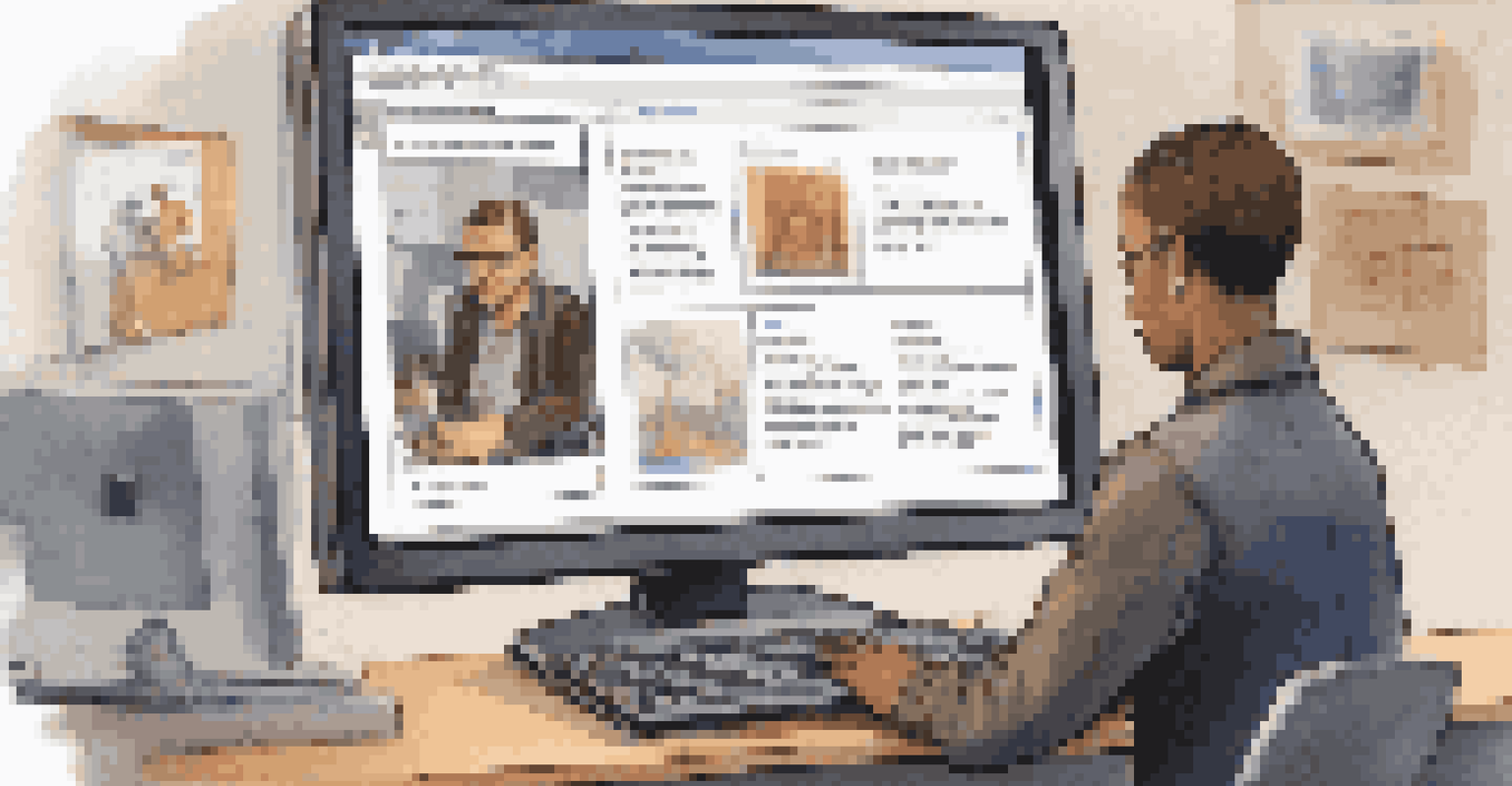Digital Portfolios: A Resource for Student-Teacher Collaboration

Understanding Digital Portfolios in Education
Digital portfolios are online collections of a student's work, achievements, and reflections. They serve as a showcase of learning, allowing students to present their skills and projects in a visually engaging manner. This format not only highlights a student’s progress but also provides a platform for them to express their creativity and individuality.
The greatest gift is not being afraid to question.
Unlike traditional portfolios, which may consist of physical papers and projects, digital portfolios are dynamic and easily updated. This flexibility enables students to add new work as they progress through their studies, making the portfolio a living document. It encourages ongoing reflection, as students can revisit past projects and see how they have evolved over time.
Additionally, digital portfolios can include multimedia elements such as videos, presentations, and links to online resources. This variety makes the portfolio more engaging for both students and teachers, providing a comprehensive view of the student's abilities and learning journey. By combining different formats, students can better articulate their learning experiences.
Benefits of Digital Portfolios for Students
Digital portfolios empower students by giving them ownership of their learning. When students curate their own work, they become more invested in their educational journey. This sense of ownership fosters motivation and a desire to excel, as they want to showcase their best work to teachers and peers.

Moreover, these portfolios encourage self-reflection, a critical skill in personal and academic growth. As students review their work, they can identify strengths and areas for improvement, leading to a deeper understanding of their learning process. This reflection can also guide them in setting future goals and aspirations.
Digital Portfolios Showcase Learning
Digital portfolios provide a dynamic, engaging way for students to present their work and reflect on their learning journey.
Finally, digital portfolios can serve as valuable tools for career readiness. As students prepare for internships or job applications, they can easily share their portfolios with potential employers or educational institutions. This not only highlights their skills but also demonstrates their ability to use technology effectively in a professional context.
How Digital Portfolios Enhance Teacher Collaboration
Digital portfolios bridge the gap between students and teachers, fostering a collaborative learning environment. Teachers can access students' portfolios to better understand their strengths, interests, and learning styles. This insight allows for more personalized instruction, catering to each student's unique needs.
Education is not the filling of a pail, but the lighting of a fire.
Additionally, portfolios create opportunities for meaningful feedback. Teachers can leave comments directly on the portfolio entries, facilitating a two-way conversation about the student's work. This ongoing dialogue helps students feel more connected to their teachers and encourages them to take their learning seriously.
Furthermore, sharing digital portfolios with colleagues can enhance collaborative teaching practices. Teachers can exchange ideas and strategies based on students' work, leading to improved instructional methods. This collaboration not only benefits individual students but also enriches the entire educational community.
Integrating Digital Portfolios into the Curriculum
To effectively integrate digital portfolios into the curriculum, educators need to set clear objectives. By defining what they want students to achieve with their portfolios, teachers can create a structured approach that aligns with learning goals. This clarity ensures that students understand the purpose and value of their portfolios.
Incorporating portfolio assignments into regular coursework is essential. For example, teachers can require students to upload their projects or reflections as part of their assessments. This integration reinforces the idea that the portfolio is a vital component of their learning, rather than an add-on task.
Empowerment Through Ownership
Students gain a sense of ownership over their education, fostering motivation and personal growth by curating their own portfolios.
Furthermore, providing students with guidelines and resources can help them create high-quality portfolios. Offering workshops or tutorials on digital tools can empower students with the skills they need to effectively curate their work. This support not only boosts their confidence but also enhances the overall quality of the portfolios.
Engaging Students with Technology and Creativity
Digital portfolios leverage technology to engage students in innovative ways. By using various digital tools, students can explore their creativity while presenting their work. This engagement can transform the learning experience, making it more interactive and enjoyable.
Moreover, technology allows for collaboration among peers. Students can share their portfolios with classmates, receive feedback, and even collaborate on projects. This sense of community encourages a supportive learning environment where students can learn from one another.
Additionally, the use of technology prepares students for the digital world they will encounter in their futures. By becoming proficient in creating and managing digital portfolios, students develop essential skills that are highly valued in today’s job market. They learn not only to showcase their work but also to navigate and utilize digital platforms effectively.
Challenges of Implementing Digital Portfolios
While digital portfolios offer numerous benefits, there are also challenges in their implementation. One of the primary concerns is access to technology. Not all students may have reliable internet access or devices, which can create disparities in the ability to create and maintain portfolios.
Another challenge is the learning curve associated with using digital tools. Some students may struggle with the technical aspects of portfolio creation, leading to frustration. Educators must be prepared to offer support and resources to help students overcome these hurdles.
Enhancing Collaboration in Education
Digital portfolios foster collaboration between students and teachers, enabling personalized instruction and meaningful feedback.
Finally, teachers may need to adjust their assessment strategies. Traditional grading methods may not fully capture the value of a digital portfolio, which emphasizes growth and reflection. Developing new evaluation criteria that align with the portfolio's objectives is essential for fair and effective assessment.
The Future of Digital Portfolios in Education
As education continues to evolve, digital portfolios are likely to become even more integral to the learning process. They align with the increasing emphasis on personalized learning and student agency, allowing students to take charge of their educational journeys. This trend reflects a broader shift towards more student-centered approaches in education.
Moreover, advancements in technology will enhance the capabilities of digital portfolios. New tools and platforms will offer even more features, making it easier for students to showcase their work and collaborate with others. This evolution will further enrich the learning experience, providing students with a robust platform to demonstrate their growth.

Ultimately, the future of digital portfolios in education holds great promise. As they become more widely adopted, these portfolios will continue to foster collaboration between students and teachers, helping to create a more engaging and meaningful learning environment. The potential for innovation and creativity is limitless, paving the way for a new era in education.